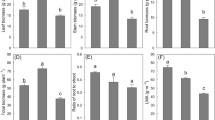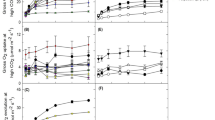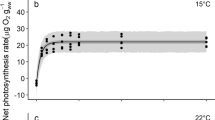Abstract
Launaea sarmentosa (Willd.) Sch. Bip ex Kunze (Asteracaeae) is a littoral sand dune herb found in the Indian Ocean region, used as a folk medicine and as a savory vegetable in Thailand. It is in the transition stage from a kitchen & cottage industry to a commercial proposition. Rapid light curves to measure the photosynthetic electron transport rate (ETR) were conducted on the plants over the course of daylight from 6:00 to 18:00 using a PAM fluorometer on plants grown under 50% (nominal) green horticultural and 20% black (nominal) shade cloth and in the open. Plants grown in the open were sun plants. Eopt (µmol photon m−2 s−1) decreased slightly under shade cloth (open air: 890 > green shade cloth, 778 > green shade cloth, 713). Launaea shows limited shade adaptation. ETR decreased under shade cloth on both a surface area and Chl a basis (µmol e− g Chl a−1 s−1) [open air: 388 > (green shade cloth, 209 = black shade cloth, 263)]. Maximum non-photochemical quenching (NPQmax) was significantly decreased under black shade cloth [(open air: 1.02 = green shade cloth, 0.969) > black shade cloth, 0.694]. ETR showed midday inhibition (9:00–15:00) when irradiance exceeded the Eopt of Launaea. Daily total photosynthetic electron transport was (mmol e− m−2 d−1): open air, 1890 ± 157; green shade cloth, 1620 ± 203, black shade cloth, 1217 ± 143. Green shade cloth has no effect on total daily photosynthetic electron transport of Launaea but offers some protection from desiccation and excessive evapotranspiration. Waterlogging decreases ETR by about 40%. Launaea can be grown watered with brackish (½ seawater) water unlike many other vegetables. Launeae is a physiologically undemanding cottage industry/market garden crop suitable for sandy coastline fishing communities.









Similar content being viewed by others
Abbreviations
- Abtλ :
-
Absorptance proportion of light absorbed by leaf at a given wavelength, AbtF is default absorptance
- (α0):
-
Photosynthetic efficiency, the initial slope of photosynthetic electron transport rate (ETR) (as e− photon−1) versus irradiance curve at E = 0 (α0 = ETRmax × e/Eopt)
- Chl a :
-
Chlorophyll a
- E:
-
Is the irradiance (µmol photon m−2 s−1 400–700 nm PPFD)
- Eopt :
-
Optimum irradiance (µmol photon m−2 s−1)
- ETR:
-
Photosynthetic electron transport rate corrected for actual absorptance (Abtλ) of leaves
- NPQ½max :
-
Irradiance (µmol photon m−2 s−1) at which non-photochemical quenching is ½ of maximum
- NPQmax :
-
Maximum non-photochemical quenching
- rETR:
-
PAM parameter relative (photosynthetic) electron transport rate
- Y (Yield):
-
PAM parameter photochemical Yield
- Y1/2 :
-
The half maximum irradiance point for yield (Y)
References
Ambajo F, Matheka JM (2016) Micropropogation of Launaea cornuta—An important indigenous vegetable and medicinal plant. Afr J Biotechnol 15:1726–1730. https://doi.org/10.5897/ajb2016.15260
Apichatmeta K, Sudsiri CJ, Ritchie RJ (2017) Photosynthesis of oil palm (Elaeis guineensis). Sci Hortic 214:34–40. https://doi.org/10.1016/j.scienta.2016.11.013
Beena KR, Ananda K, Sridhar KR (2000) Fungal endophytes of three sand dune plant species of west coast of India. Sydowia 52:1–9
Brestic M, Zivcak M (2013) PSII fluorescence techniques for measurement of drought and high temperature stress signal in plants: protocols and applications. In: Rout GR, Das AB (eds) Molecular stress physiology in plants. Springer, Dordrecht, pp 87–131
Cochran WG, Snedecor GW (1989) Statistical methods, 8th edn. Iowa State University Press, Ames, p 503
Gueymard C (1995) A simple model of the atmospheric radiative transfer of sunshine: algorithms and performance assessment. In: Professional Paper. Florida Solar Energy Centre, Cocoa, pp 1–78
Gueymard C (2001) Parametised transmittance model for direct beam and circumsolar spectral irradiance. Sol Energy 71:325–346
Fioretto A, Alfani A (1988) Anatomy of succulence and CAM in 15 species of Senecio. Bot Gaz 149:142–152. https://doi.org/10.1086/337701
Kerbauy GB, Takahashi CA, Lopez AM, Matsumura AT, Hamachi L, Félix LM, Pereira PN, Freschi L, Mercier H (2012) Crassulacean acid metabolism in epiphytic orchids current knowledge future perspectives. In: Najafpour M (ed) Applied photosynthesis, chapter 4. BoD-Books on Demand, Norderstedt, pp 81–104
Kulkarni SS, Raviraja NS, Sridhar KR (1997) Arbuscular mycorrhizal fungi of tropical sand dunes of West Coast of India. J Coast Res 13:931–936
Hak K, Ritchie RJ, Dummee V (2019) Bioaccumulation and physiological responses of the coontail, Ceratophyllum demersum exposed to copper, zinc and in combination. Ecotoxicol Environ Saf 189:110049. https://doi.org/10.1016/j.ecoenv.2019.110049
Lambrev PH, Miloslavina Y, Jahns P, Holzwarth AR (2012) On the relationship between non-photochemical quenching and photoprotection of photosystem II. Biochem Biophys Acta 1817:760–769. https://doi.org/10.1016/j.bbabio.2012.02.002
Lüttge U (2010) Ability of Crassulacean acid metabolism plants to overcome interacting stresses in tropical environments. AoB Plants. https://doi.org/10.1093/aobpla/plq005
Mahesh A, Thangadurai D, Melchias G (2012) Rapid in vitro plant regeneration from leaf explants of Launaea sarmentosa (Will.) Sch Bip Ex Kuntze. Biol Res 45:131–136
Montero E, Francisco AM, Montes E, Herrera A (2018) Salinity induction of recycling crassulacean acid metabolism and salt tolerance in plants of Talinum triangulare. Ann Bot 121:1333–1342. https://doi.org/10.1093/aob/mcy030
Najeeb U, Bange MP, Atwell BJ, Tan DKY (2016) Low incident light combined with partial waterlogging impairs photosynthesis and imposes a yield penalty in Cotton. J Agron Crop Sci 202:331–341. https://doi.org/10.1111/jac.12164
Quinnell R, Howell D, Ritchie RJ (2017) Photosynthesis of an epiphytic resurrection fern Davallia angustata (Wall, ex Hook. & Grev.). Aust J Bot 65:348–356. https://doi.org/10.1071/BT16222
Raju GS, Moghal MMR, Hossian MS, Hassan MM, Billah MM, Ahmed SK, Rana SMM (2014) Assessment of pharmacological activities of two medicinal plants of Bangladesh Launaea sarmentosa and Aegialitis rotundifolia roxb in the management of pain, pyrexia and inflammation. Biol Res 47(1):55
Ralph PJ, Gademann R (2005) Rapid-light-curves: a powerful tool to assess photosynthetic activity. Aquat Bot 82:222–237. https://doi.org/10.1016/j.aquabot.2005.02.006
Rao TA, Meher-Homji VM (1985) Strand plant communities of the Indian subcontinent. Proc Indian Acad Sci 94:505–523
Ritchie RJ (2012) Photosynthesis in the blue water lily (Nymphaea caerulea Saligny) using PAM fluorometry. Int J Plant Sci 173:124–136. https://doi.org/10.1086/663168
Ritchie RJ (2018) Measurement of chlorophylls a and b and bacteriochlorophyll a in organisms from hypereutrophic auxinic waters. J Appl Phycol 30(6):3075–3087. https://doi.org/10.1007/s10811-018-1431-4
Ritchie RJ, Bunthawin S (2010a) The use of PAM (Pulse Amplitude Modulation) Fluorometry to measure photosynthesis in a CAM orchid, Dendrobium spp. (D. cv. Viravuth Pink). Int J Plant Sci 171:575–585. https://doi.org/10.1086/653131
Ritchie RJ, Bunthawin S (2010b) The use of PAM (Pulse Amplitude Modulation) fluorometry to measure photosynthesis in pineapple (Ananas comosus [L.] Merr). Trop Plant Biol 3:193–203. https://doi.org/10.1007/s/12042-010-9057-y
Ritchie RJ, Runcie JW (2014) A portable reflectance-absorptance-transmittance (RAT) meter for vascular plant leaves. Photosynthetica 52:614–626. https://doi.org/10.1007/s11099-014-0069-y
Sage RF (2016) A portrait of the C4 photosynthetic family on the 50th anniversary of its discovery: species number, evolutionary lineages, and Hall of Fame. J Exp Bot 67:4039–4056. https://doi.org/10.1093/jxb/erw156
Sakpere AMA, Aremu OA (2008) The growth of Launaea taraxicifolia (Asteraceae) and its response to shading. Res J Bot 3:90–96
Salih Y, Harisha CR, Vinay J, Shukla VJ, Acharya R (2020) Pharmacognostical evaluation of Launaea sarmentosa (Willd.) Schultz-bip.ex Kuntze root. AYU 34:90–94. https://doi.org/10.4103/0974-8520.115439
Sa Sam Viet Joint Stock Company (2020) A process of growing Launaea sarmentosa on sea sand in Ben Tre Province. Vietnam Agriculture—Weekly summary of agriculture news from Vietnam (December 9, 2019–December 15, 2019) Ministerie van Landbouw, Natuur en Voedselkwaliteit Bezuidenhoutseweg 732594 AC Den Haag, The Netherlands
Sma-Air S, Ritchie RJ (2020) Photosynthesis in a Vanda sp orchid with photosynthetic roots. J Plant Physiol 251:153187. https://doi.org/10.1016/j.jplph.2020.153187
Tipgailard P (2020) Launaea on the southern beach create extra income for Phuket farmers (in Thai + photographs of collection site). Home Agric Mag 44(12):136
Winter K (2019) Review Paper ecophysiology of constitutive and facultative CAM photosynthesis. J Exp Bot 70:6495–6508. https://doi.org/10.1093/jxb/erz002
Acknowledgements
This study of Launaea physiology was partially funded by a grant from The National Science and Technology Development Agency (NSTDA) of Thailand (P. Thongchumnum and K. Kanjanachatree). The project was also partially funded by Prince of Songkla University-Phuket, Faculty of Technology and Environment and ANED (Andaman Environment and Natural Disaster Research Centre). The authors wish to thank the university for access to their facilities. The authors also wish to thank the director and other staff of Sirinath National Park (Natthawat Nuisriram, Winai Sae-io, Wichai Takarnkit and Nette Daechakul) who co-operated in the project. We would also like to thank Assoc Prof. Daniel Tan (Sydney University, Agriculture) for his helpful comments on the study.
Author information
Authors and Affiliations
Corresponding author
Ethics declarations
Conflict of interest
Suhailar Sma-Air was employed to assist in the project by Raymond J. Ritchie; otherwise, there are no conflicts of interest.
Additional information
Publisher's Note
Springer Nature remains neutral with regard to jurisdictional claims in published maps and institutional affiliations.
Supplementary Information
Below is the link to the electronic supplementary material.
Rights and permissions
About this article
Cite this article
Ritchie, R.J., Sma-Air, S., Limsathapornkul, N. et al. Photosynthetic electron transport rate (ETR) in the littoral herb Launaea sarmentosa known as mole crab in Thailand. Photosynth Res 150, 327–341 (2021). https://doi.org/10.1007/s11120-021-00826-2
Received:
Accepted:
Published:
Issue Date:
DOI: https://doi.org/10.1007/s11120-021-00826-2




